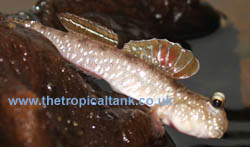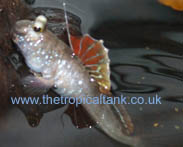

Photos © Sean Evans
|
| Common name: | Indian Mudskipper, Pearse's Mudskipper |
| Scientific name: | Periophthalmus novemradiatus |
| Synonyms: | Periophthalmus pearsei, Periophthalmus variabilis, Gobius novemradiatus |
| Size: | 2.5" (6cm). |
| Origin: | Asia: India, Myanmar, Thailand, Malaysia, Indonesia, and the Philippines. |
| Tank setup: | A brackish water tank with a beach/land area is required. A tight-fitting cover should be used to prevent escape,
as these fish can use their pelvic fins like a sucker to climb the glass. A tight-fitting cover also helps to maintain high humidity on the land areas. |
| Compatibility: | Territorial with their own kind, but not overly aggressive. |
| Temperature: | 25-29oC (77-84oF) |
| Water chemistry: | Brackish water with an alkaline pH. The specific salt level is not overly important, as they will
thrive in a wide range of salinities, but should not be maintained in freshwater for any length of time. Medium brackish conditions (sg 1.005 - 1.015) are ideal, and the salinity can
be varied within this range. |
| Feeding: | Carnivore that eats insects, worms and crustaceans. In the aquarium, frozen or live foods such as bloodworm,
brine shrimp (Artemia), mysis and krill may be used. Dry foods such as flake and granular foods are also eaten and can be used to complete a varied diet.
Small crickets or other insects can be introduced onto land areas as a treat to vary the diet and stimulate natural behavior. |
| Sexing: | Males have a larger dorsal fin, with an elongated first spine. |
| Breeding: | Unknown in aquaria. In the wild, eggs are laid inside burrows dug into mud. |
| Comments: |
There is some doubt as to whether the species regularly imported as the Indian mudskipper is definitely Periophthalmus novemradiatus. Some pictures of this species show quite
different colouration - however, this may represent regional variation due to its wide distribution. The "Indian Mudskipper" regularly imported does possess nine spines in the first dorsal fin
that give rise to the species name. Periophthalmus chrysospilos, a similar species also found in India, may have 7 - 10 spines, but this species normally shows yellowish-gold
spots on the body.
|





